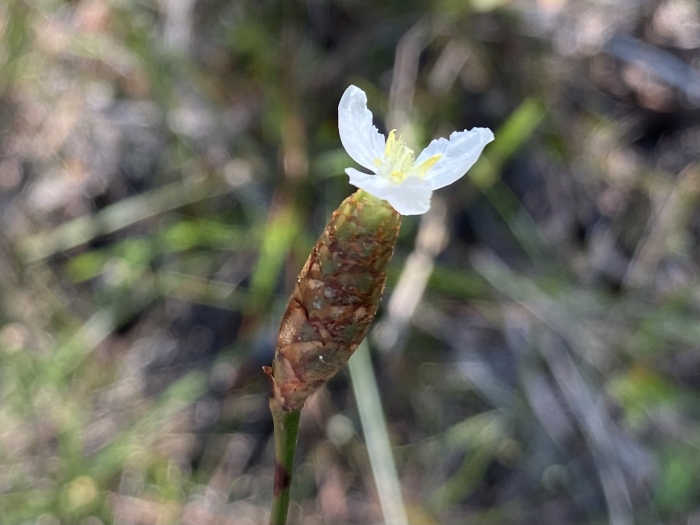Carolina Yellow-Eyed Grass
(Xyris caroliniana)
Carolina Yellow-Eyed Grass (Xyris caroliniana)
/
/

Karen Guin
CC BY 4.0
Image By:
Karen Guin
Recorded By:
Copyright:
CC BY 4.0
Copyright Notice:
Photo by: Karen Guin | License Type: CC BY 4.0 | License URL: http://creativecommons.org/licenses/by/4.0/ | Rights Holder: Karen Guin | Publisher: iNaturalist | Date Created: 2023-07-30T13:59:31Z |

























Estimated Native Range
Summary
Xyris caroliniana, commonly known as Carolina yellow-eyed grass, is a perennial herb native to wet pine flatwoods, savannas, and bogs in the coastal plain of the southeastern United States, extending from eastern Texas to New Jersey, and also found in Cuba. It typically grows up to 40 inches tall, with narrow, grass-like leaves that can reach 20 inches in length. This plant produces distinctive yellow flowers that appear on cone-like heads atop slender stalks during the summer months, adding a splash of color to the landscape.
Carolina yellow-eyed grass is valued for its unique flowering heads and its ability to thrive in wet, acidic soils, making it a suitable choice for rain gardens, wet meadows, and naturalized areas. It is also used for its ornamental value in water features or as a bog plant in garden ponds. In cultivation, it prefers full sun to part shade and requires consistently moist to wet soil conditions. While it is not commonly found in the nursery trade, it can be propagated by seed or division. Gardeners should be aware that this plant may require additional water during dry periods to maintain its health.CC BY-SA 4.0
Carolina yellow-eyed grass is valued for its unique flowering heads and its ability to thrive in wet, acidic soils, making it a suitable choice for rain gardens, wet meadows, and naturalized areas. It is also used for its ornamental value in water features or as a bog plant in garden ponds. In cultivation, it prefers full sun to part shade and requires consistently moist to wet soil conditions. While it is not commonly found in the nursery trade, it can be propagated by seed or division. Gardeners should be aware that this plant may require additional water during dry periods to maintain its health.CC BY-SA 4.0
Plant Description
- Plant Type: Herb
- Height: 1-2 feet
- Width: 0.5-1 feet
- Growth Rate: Moderate
- Flower Color: White, Yellow
- Flowering Season: Summer, Fall
- Leaf Retention: Evergreen
Growth Requirements
- Sun: Full Sun, Part Shade
- Water: High
- Drainage: Slow, Standing
Common Uses
Low Maintenance, Water Garden
Natural Habitat
Native to wet pine flatwoods, savannas, and bogs in the coastal plain of the southeastern United States and Cuba
Other Names
Common Names:
Scientific Names: , Xyris caroliniana, Kotsjiletti flexuosa, Ramotha floridana, Xyris arenicola, Xyris canadensis, Xyris caroliniana f. caroliniana, Xyris caroliniana f. flaccida, Xyris caroliniana f. phyllolepis, Xyris caroliniana var. brevifolia
GBIF Accepted Name: